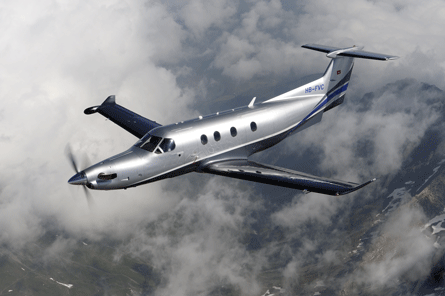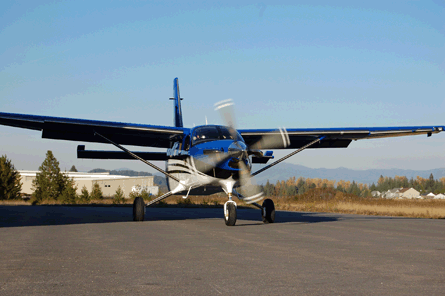It has been a bumpy ride for makers of single-engined turboprops. Even these niche players have not been immune to the economic misery and have seen sales of their fuel-efficient, versatile, multi-mission types tumble over the past 12 months.
"It has been a very tough year," says Ignaz Gretner, vice-president of general aviation for Pilatus Aircraft, Swiss maker of the PC-12NG single-engined turboprop. "There are fewer prospects because aircraft are not a priority for many people at the moment."
The privately owned company - one of Europe's last remaining independent airframers - delivered 79 PC-12s last year - 21 fewer than in 2009 - and crossed the magical boundary of 1,000 PC-12 deliveries in June. "Between 80% and 90% of our aircraft are sold in executive configuration to owner-flyers or companies that fly the aircraft professionally," says Gretner.
 |
|---|
© Pilatus |
Pilatus's traditional markets of Europe and the USA are "so slow", he says, but the airframer is concentrating on expanding its dealerships, particularly in eastern Europe and Russia. "We are keen to strengthen our Pilatus Centre network, where companies purchase aircraft directly from us and then sell them on to customers," says Gretner. "This is a particularly effective way of selling aircraft because these dealerships are effectively stakeholders in Pilatus and have a vested interest in shifting PC-12s."
Despite the tough economic climate, Pilatus is seeking to launch a new twin-engine aircraft next year - although it remains tight-lipped about the specification of the type - dubbed the PC-24. "We have always said we plan to develop a family of business aircraft, but we are a relatively small manufacturer and it is vital that we get it right," says Gretner.
This view is echoed is Daher Socata, developer of the high-speed TBM 850. The French aerostructures company is also seeking to expand its aircraft family and is evaluating the SPn light business jet with a view to acquiring the programme (see separate box). "It is very important for us to take our time with the evaluation process so we make the right decision for the company," says Nicholas Chabbert, Daher Socata's senior vice-president.
The company, which is celebrating its 100th year of operation, delivered 38 TBM 850s last year - two more than in 2009, but 22 fewer than in 2008. Chabbert says the backlog has climbed to a more "comfortable level", helped by a drop in the number of used TBMs for sale - about 8% of the 550 TBM inventory. To stimulate business and extend the life of the older TBM types, Socata has introduced a retrofit programme for the 700A and B models, which includes a Garmin G1000 glass cockpit. Three aircraft have been delivered to date, including the second of 26 700As for the French air force.
Fellow single-engined turboprop maker Quest Aircraft has set its sights on the owner-flyer market with its multi-mission Kodiak 100. The 10-year-old company has so far delivered 47 of the high-wing aircraft to missionary, humanitarian, government and utility operators, but a large cash injection by an unnamed investor into Sandpoint, Idaho-based Quest in March paved the way for expansion into new sectors, including charter and corporate.
"We haven't really spent much on marketing and sales up until now as the orderbook for the Kodiak has remained strong," says Quest chief executive Paul Schaller. The investment has also enabled Quest to expand into new markets, notably South Africa, where the Kodiak is already certificated, Brazil and Australia, where validation has been applied for, he says. To help boost the Kodiak's appeal with the VIP market, Quest last month won supplemental type certification for the aircraft's air conditioning system and will develop an executive interior called the Summit.
 |
|---|
© Quest Aircraft |
Despite the unstable economic climate, there seems enormous confidence in the long-term future of single-engined turboprops.
Alan Klapmeier, former chief executive of Cirrus Design, gave his endorsement to the sector last year when he acquired the rights to the British-designed Kestrel. He plans to unveil a new prototype of the aircraft - formerly known as the Farnborough F-1 - later this year.
Hawker Beechcraft, which is new to the turboprop single market but a long-term builder of twin turbines, is believed to be working on designs for a clean-sheet aircraft aimed at the utility market.
Meanwhile, Cessna, maker of the Caravan turboprop single, has stated its intention to introduce a new turboprop that will fill a product gap between its 235kt (435km/h) piston-powered 400 Corvalis TT and the 340kt Mustang twin-engined very light jet.
"We are looking at a pressurised performance aircraft with a price point in the $1.5-2.5 million range and a top speed of more than 300kt," says Cessna president Jack Pelton. "There is a gap in our product line for people to move into."
Cessna's 27-year-old, 12-passenger, $2 million Caravan has a maximum cruise speed of 186kt and Pelton says this aircraft has "really held it own" throughout the economic downturn thanks to its appeal to a wide range of users.
"The Caravan has so many applications and has become a very popular choice with revenue-making operators such as cargo and charter," says Pelton. He admits Cessna's focus on utility and commercial operators has helped to cushion the Caravan from the worst effects of the downturn. Last year, Cessna delivered 95 Caravans - just two fewer than in 2009 - and expects to hand over a similar number this year.
Piper Aircraft has not courted the same success with its Meridian turboprop single. Sales of the seven-seat aircraft plummeted for the third year in a row - from 53 in 2007 to 25 in 2010 - as it struggled to secure sales from a shrinking and competitive owner-flyer market.
Source: Flight International




















